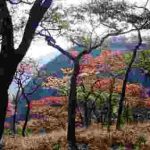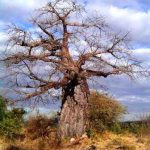TREE LIFE
JANUARY 2002
MASHONALAND CALENDAR
Saturday 5 January (Moved from December 22). Mark’s walk will be at the home of Dr Peter Iliff at 7, Ernie’s Lane, Monavale, which we last visited in June 2001.
Tuesday 8 January NB Change of date. Botanic Garden Walk. Meet in the car park of the Botanic Garden at 4.45 for 5 pm where we will meet Tom and continue with the Rubiaceae family.
Sunday 20 January. Tony and Jo Alexander have invited us to spend the day with them in the Ruwa area.
Thursday 31 Jan. to approx Tuesday 5 Feb.
If all is well, a trip to Jenny and Kurt Braunstein’s wonderful property in the Juliasdale/Nyanga area is planned. Because of the prevailing uncertainty please phone Maureen Silva-Jones if you are interested and you will be notified when definite plans are made. It will be a self-catering weekend with space for your camp bed in a large house.
Tuesday 5 February Botanic Garden walk
MATABELELAND CALENDAR
No arrangements have been made for January. Contact Jonathan Timberlake if you would like to organize a future outing.
TREES AND BEES
At the Tree Society outing on 18 November 2001 hosted by Adrian and Debbie Swales at Kieray Estate, Darwendale, not much was seen in the way of honeybee activity.
While members were working their way through Meg’s key to identify a small scraggly Capparaceae shrub which was in flower, and as I have observed bees on other Capperaceae, I decided to have closer look. Sure enough, there were a few bees collecting nectar despite the disturbance by society members. It was eventually decided that it was Maerua triphylla. Reinhard Fichtl in Honeybee Flora of Ethiopia records M. angolensis as being a useful bee tree. “Honeybees are foraging frequently for pollen and nectar throughout the day” are his comments.
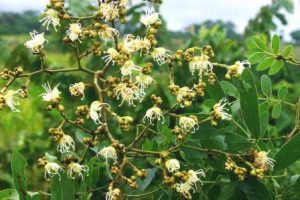
Julbernardia globiflora. Photo: Bart Wursten. Source: Flora of Zimbabwe
The only other tree on which I saw honeybees working was a Julbernardia globiflora in the Swales’s garden, which was just coming into flower. This summer-flowering tree can be a very good source of nectar and is much sought after by honeybees. Heavy rain can dilute and even wash out nectar from the flowers and, of course, prevent bees from flying, so beekeepers are not too keen on prolonged rainy periods. This J. globiflora was seen whilst we were looking at a five year old Tamarindus indica in the garden which was also in full flower. No bees were seen working this tree and some discussion took place as to what the pollinating agents might be. I am not too familiar with this tree so I was unable to shed any light on the matter. Referring to Fichtl, he is enthusiastic about this tree which he recommends for planting to increase honey production. The honey from this tree is described as “a dark honey which has a thin viscosity and a sour, but pleasant, flavour.”
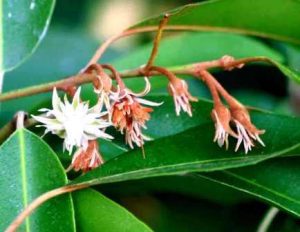
Mimusops zeyheri. Photo: Bart Wursten. Source: Flora of Zimbabwe
During the morning, Ann Bianchi pointed out two trees which the South Africans are looking at for fruit production: Englerophytum magalismontanum (some momentary confusion here due to a recent name change!) and Mimusops zeyheri. Bees collect nectar from both these trees but I am unable to find any references to the honey characteristics.
A few Peltophorum africanum were seen, but none in flower. This is a useful bee tree for both pollen and nectar and has a nice long flowering period.
Watching bees collecting pollen rom Peltophorum africanum is quite fascinating. They rapidly scramble around the open flower getting pollen grains stuck to their body hairs, then back off and hover in mid-air transferring the pollen from their bodies to the pollen baskets of their back legs, then repeat the exercise on the next flower.
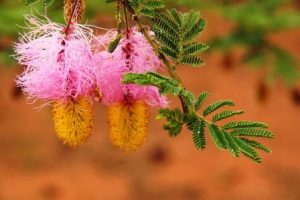
Dichrostachys cinerea. Photo: Bart Wursten. Source: Flora of Zimbabwe
Two pioneer trees seen and discussed namely Terminalia sericea and Dichrostachys cinerea are of interest to beekeepers. I love watching bees collecting pollen from Dichrostachys cinerea – they walk rapidly round and round the lower, yellow part of the flower getting coated with pollen grains. They do the pollen transfer while resting on the flower, not hovering in mid-air. Fichtl states they also collect nectar, but this I personally haven’t seen. No description of the honey is given.
Terminalia sericea has a negative aspect for beekeepers. Readers may be familiar with the smell of the flowers which I have heard described as being like sweaty socks – the honey is said to taste like the smell of the blossom! This is probably so, as from hives I had at Kariba one year I collected honey which tasted just like the smell of Terminalia stuhlmannii which had been flowering profusely shortly before. Fichtl makes no mention of any Terminalia in his book. My Kariba Terminalia honey was a light amber colour with a very distinct, but not unpleasant, flavour.
-Peter Taylor
Thank you Adrian and Debbie for a wonderful day at your beautiful Kaya ye Kondo and your warm hospitality.
We thank Rob Burrett for his fascinating talks at the rock art and grave sites this Sunday and over many years Although Rob is leaving for SA we hope that when he visits Zim. he will find time to join us on our outings .
In the meantime ‘Go well’ Rob.
BOTANIC GARDEN WALK: 4 DECEMBER 2001
Today’s subject was the family Rubiaceae. This is a large family in Zimbabwe (measured by the number of species) with numerous annual and perennial herbs, suffrutices, shrubs and trees. Although not too taxonomically difficult in the savanna areas, it is a family which poses a serious identification problem in the Eastern Districts where there are numerous similar-looking species which occur commonly. Furthermore, the characters used to separate the genera are not at all easy.
What are the characteristics of the family?
- leaves opposite or less often in whorls
- leaves usually simple and entire
- petals fused together to form a tube, which is often lobed above;
- ovary inferior
- stipules present and often interpetiolar
Other families which it might be confused with are as follows:
Rhizophoraceae – e.g
opposite leaves and interpetiolar stipules but the leaves have serrate margins.
Caprifoliaceae: this is not a problem in Zimbabwe as only a few rare alien species of this family occur. It has the characteristics listed above but the stipules are absent or minute.
The first species we looked was a species from Malawi, namely Burttdavya nyasica. This illustrated well most of the features of the family, although this species is a bit unusual in that its flowers occur in spherical inflorescences. It occurs in the Shire valley in Malawi and its trunks are used as dug-out canoes in the Zambezi valley. The flowers are aromatic and produce plenty of nectar.
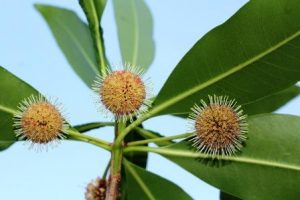
Breonadia salicina. Photo: Bart Wursten. Source: Flora of Zimbabwe
One species in Zimbabwe which also has spherical heads is Breonadia salicina. This is a species of riverine habitats in the Eastern Districts where it occurs at middle and low altitudes and it can become a very large tree indeed. The leaves are whorled and it grows with and may be confused with Rauvolfia caffra. However, the latter has milky latex which the Breonadia does not. Another difference pointed out I think by Meg Coates Palgrave is that in Rauvolfia the leaves hang down whereas they are more erect in Breonadia.
We then looked at a number of rather rare Rubiaceae from low to medium altitude Eastern Districts forests. Pyrostria bibracteata occurs in small forest patches at the foot of the Chimanimani mountains and in the Burma Valley below the Vumba. Like many other species of the family, it has very regular opposite branching.
Tarenna supra-axillaris occurs in small outliers of low altitude forest, e.g. near Mt Peni. This has typical dark green glossy leaves of the forest trees. The specific name refers to the inflorescences which were indeed “supra-axillary” – which means that they do not arise from a node where you would expect them but from a higher point.
Canthium ngonii, which is a fairly recent name and is named after the late John Ngoni of the National herbarium, looked a fairly distinctive shrub with small, neat leaves and a marked long-attenuate apex. It is another low altitude species occurring at Mt Dombi. Its habitat is in the ecotone where forest and Brachystegia woodland meet.
Another medium to low altitude species is Tricalysia myrtifolia. Tom observed that Tricalysia is a difficult genus. This species is a shrub or medium-sized tree to 10 m. It occurs at Witchwood in the Vumba and in the Chirinda Forest.
We then examined two specie of Oxyanthus. One was O. goetzei, formerly known as O. swynnertonii. This occurs only in the Chirinda Forest and is an understorey forest. The flowers are attractive and the species could be grown as an ornamental.
The much commoner species is Oxyanthus speciosus. We have seen this on our outings to the Chinamora Communal Land and specifically near Ngomakurira. The leaves are exceptionally large and dark green. It is a forest species or occurs in riverine and high rainfall areas such as at Chinamora.
Another species seen was Cremaspora triflora. This has white flowers in small inflorescences arranged along the branches in the axils of the leaves. Meg pointed out the unusual feature of “spare” leaves which appear to subtend the upper branches. Cremaspora is a species of medium altitude forest.
Unfortunately, I had to leave early and so missed the rest. However, I expect that we will be carrying on with this family next month.
Our very great thanks go to Tom for helping us to elucidate this exceptionally difficult family.
-Mark Hyde
PARTHENIUM HYSTEROPHORUS IN ZIMBABWE
Parthenium hysterophorus L. Compositae, common names parthenium, Demoina weed, white-top, congress weed, American feverfew, carrot weed among others, is an annual, erect and diffusely branched herb which may grow over 100cm tall. Parthenium has a deep tap root, pale green, deeply lobed, softly hairy leaves. It bears many small white flowers at the tips of the stems and each flower contains four to five black, wedge-shaped seeds with two thin, white scales. The genus name is derived from the similarity to feverfew (Tanacetum parthenium) and hysterophorus is derived from the Greek hystera (womb) and phorus (bearing), probably a reference to its seeding ability. Parthenium is an invasive weed of bare or disturbed ground which originates from the Americas but has shown an ability to adapt to a wide variety of conditions and has become a serious pest in many countries.
Introduced into India in the 1950s, parthenium has spread widely and is particularly a problem due to its allergy-causing potential amongst agricultural workers. P. hysterophorus is a cause of airborne allergen contact dermatitis i.e. contact with wind-borne pollen and/or desiccated plant material can initiate a dermatological reaction. However, contact with all parts of the plants except the roots may induce allergy. A sesquiterpene lactone, parthenin, has been identified and is suspected to be the major allergen of the species. Other identified phytochemicals include phenolic acids such as caffeic acid, vanillic acid, chlorogenic acid, p-hydroxybenzoic acid and p-anisic acid (International Parthenium Research News Group https://www.iprng.org/IPRNG-main.htm). The allergic responses reported are widely different in presentation from localised irritation to extensive exfoliative dermatitis. Lichenified plaques may result following chronic exposure.
In Australia, parthenium has been declared a pest due to its effect on agricultural production. Parthenium inhibits the seed germination and growth of nearby plants through chemical messengers (allelopathy). In 1992 it was estimated to cause a loss of A$16.5 million per annum due to reduce beef production and costs of control measures. Crop production has also been affected (Queensland Government Natural Resources and Mines factsheet on Parthenium Weed, 2001; https://www.dnr.qld.gov.au).
In South Africa, P. hysterophorus was first identified in Natal in 1880. However, it has become more of a problem since the 1980’s (Parthenium Infestation Status In Southern Africa. L Henderson, Agricultural Research Council-Plant Protection Research Institute, South Africa). Its distribution is mostly along the eastern border of South Africa from KwaZulu-Natal northwards to the southern Kruger National Park although specimens have been recorded near Pretoria. It has become a particular nuisance in sugar cane and banana plantations. Due to its aggressive colonising of wasteland, roadsides, railsides, watercourses, cultivated fields and overgrazed pastures, parthenium has been declared a Category One weed making it a prohibited plant. The name Demoina weed is thought to be a reference to its spread after Cyclone Demoina although this could not be confirmed.
Seed dispersal of parthenium is usually by water and to a lesser degree via wind. Spread over distance is often a result of movement of animals or machinery with mud containing the seeds. Allowing for seed drop from coats and washing of mud when moving from contaminated pastures to parthenium-free areas are important to limit the spread. Other control measures for parthenium include herbicides, competitive plant species and biocontrol through beetles and fungi. In India, Cassia sericea has been found to be a useful competitor of parthenium particularly around households and empty plots. Zygogramma bicolorata beetles have been proposed as another biological control but they also feed on sunflowers. Various fungi including Fusarium and Colletotrichum species have been tested as mycoherbicides. Movement of animals and machinery is an important method of spread of the weed over distances.
Parthenium has only been observed in Zimbabwe fairly recently (MA Hyde, pers. comm.). There is no record of it for Zimbabwe in Wild (1967) although it was present in Mozambique, and the first observation here appears to have been at Rainham Dam in the 1980s. It appears to be spreading with specimens seen along roadsides in Harare, the main Harare/Mutare Road near Mutare and in the rhino enclosures at Chipangali wildlife sanctuary near Bulawayo. This is of concern because of the adverse effects on both agriculture and human health and it is something which needs close observation in the future.
-Douglas Ball
TREE BARK AS A DIAGNOSTIC CHARACTER
Occasionally there have been suggestions in TREE LIFE articles that certain bark characteristics have diagnostic value for identification purposes. Bark characteristics can certainly be useful aids to identification, but one should be very wary of relying on them for diagnostic purposes. An eminent eucalypt taxonomist has pointed out that bark is the one part of the tree that is permanently subjected to ageing and to the vagaries of the weather. Leaves, flowers, and fruit appear on the tree, live for their allotted time, and then all. Bark, too, may be shed or abraded off, but it may last a very long time, and in the course of that time it is modified by age and by the elements. Its diagnostic reliability, therefore, is low.
Two examples of this have recently cropped up with me. A fairly large specimen of acacia on Charmwood was identified and labelled as Acacia sieberiana on the basis of its pale-coloured bark. The leaves were completely out of reach, but I could see straight thorns, and although the bark was not all that good for A. sieberiana (and you will often see this tree without any “paper” bark), it seemed to fit this species better than it did any other. Surprise, surprise when yellow flowers appeared above the crown! This was A. karroo, and had the leaves been accessible, or had there been any old pods about I might have got it right first time. It was Mark who raised doubts about it being sieberiana, and suggested karroo. The yellow flowers confirmed his suggestion, and it has turned out to be the only karroo on the property.
In the last few days I have found Zanha africana in a rather inaccessible area on the same property – a small population comprising two large and apparently over-mature trees, with a number of young plants coming up around them. This means either that the two trees have to be male and female (the species is dioecious), or that they are reproducing by root suckers. But this is not the point of the story. There is no sign on the mature trees of the “typical” flaking away of the old bark to be replaced by patches reddish new bark. It is unwise, then, to rely on that bark characteristic for diagnostic purposes. It is helpful if you find it, but don’t put your shirt on it!
-Lyn Mullin
SOUTH EAST LOWVELD TREES
Two articles in Tree Life December 2001 No. 262, reminded me of my early days in the Lowveld.
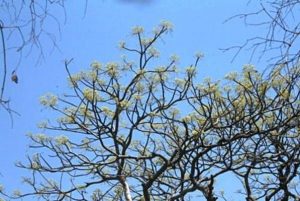
Kirkia acuminata. Photo: Mark Hyde. Source: Flora of Zimbabwe
The article covering the 6 November 2001 Botanic Garden walk on trees in rocky places discusses Kirkia acuminata which is one of my favourite trees. When I first went to the Lowveld in the early 1960s and was stationed at Chipinda Pools, I always noticed it as it stood out against the other trees covering the Chuanja Hills. It was the last tree to come into leaf in the Spring, so its bare branches made it conspicuous and it was also the first to lose its leaves in late Summer, and the beautiful, yellow and golden foliage again made it stand out against the other, as yet, still green trees.
During the Tsetse Control bush-clearing exercise, the Shangaan people collected the timber and carved wooden bowls and ornate spoons from it. At the nearby sugar estates of Hippo Valley and Triangle before they were all allocated numbers a section on each of the Estates was called “Syringa Section” because of the Kirkia acuminata growing near the homestead sites. High Syringa Game Park at Triangle is also named after this tree. It is a good bee tree and produces a pale coloured honey with a distinctive aroma and flavour.
John Wilson’s article on Tamboti Spirostachys africana also takes me back to my early Tsetse Control days where the Shangaans I worked with pointed out to me the inadvisability of using wood from this tree on a cooking fire because the smoke is poisonous. However, they would put a log on the fire last thing at night to discourage mosquitoes, and one of the pleasures of camping in the Lowveld is the late evening aroma of Tamboti wood smoke.
As with the other Euphorbiaceae Androstachys johnsonii discussed a few issues back by John and myself, Spirostachys africana has negative connotations from a beekeeper’s point of view, producing a honey said to be poisonous.
-PETER TAYLOR
MARK’S WALK, UNIVERSITY OF ZIMBABWE 24 NOVEMBER 2001
It is sad that Mark’s Walks do not get much press coverage in Tree Life due to a lack of willing scribes in the small but dedicated groups which attend. Sad, because I would like to learn more of the herbaceous flora around us and also perhaps because Mark’s selfless work at organizing these Saturday afternoon outings is not given the recognition it deserves. I therefore decided to provide a little insight from our wanderings around the vlei at the University. Due to the volume of plants we saw it is not possible or desirable to mention them all, but I will rather concentrate on those which aroused interest or discussion.
White flowers of Scabiosa columbaria greeted us, with Mark noting how he finds it unusual that this is the same species which abounds in Europe but with a pink flower. Apparently its name is derived from the fact that it was used to treat scabies. With the cost of medicines these days we might have to return to such treatments. Ash trees (Fraxinus spp.) lined the drainage ditch down towards the vlei. This member – or perhaps one should say members since there appears to be more than one species around Harare – of the Oleaceae family frequently escapes in wet places. One of its most striking features are the tight clusters of winged fruits which were conspicuous at this time.
Various members of the Asclepiadaceae were observed. These plants have opposite or whorled leaves, a milky sap, paired fruits and the seeds have a hairy canopy which aids their spread with the wind. The Vernonias were also represented by a number of members. The purple petals of the pea-flowered Vigna monophylla attracted attention. The key feature of this Vigna is, of course, the simple leaves as suggested by the specific name.
As one might expect, grasses were over represented in the vlei. Perhaps we need an outing just to look at grasses but Mark took time to point out various genera – Aristida junciformis (not a particularly robust looking grass), Setaria spp. (is it true that Setaria are usually of sour taste?), Imperata cyclindrica (flowers whilst the weather is still hot and dry before other grasses), Bothriochloa insculpta, three Paspalum species, Echinochloa, Anthropogum, Hyparrhenia, Sporobolis pyramidalis, Dicanthium, to mention just those I could confirm the spelling of.
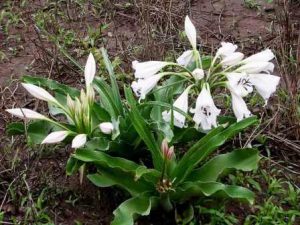
Crinum macowanii. Photo: Colin Wenham. Source: Flora of Zimbabwe
The vlei was conspicuously decorated with Crinum macowanii in flower and fruit. This is a member of the Amaryllidaceae with the 3 features of this family (separating it from similar families) being the flowers in umbels, having inferior ovaries and 6 stamens rather than 3. Testing of the leaves and seeds for oxalates did not produce the stinging pain characteristic of some Amaryllidaceae although it was not pleasant to the taste buds.
The buttercup (Ranunculus multifidis) mixed its yellow flowers with those of Nidorella resedifolia. Another yellow-flowered object of our attention was Conyza pinata, which is usually found in the Eastern Districts with very few colonies outside of this range. Mark was pleased to see this and plucked a sample, much to the chagrin of two metallic-green longicorn beetles which were disturbed in their amorous advances to one another.
Commelinas crept amongst the grasses with their flowers just starting to peer out of the spathes. Apparently, a common name for Commelinas is the “Wandering Jew” although quite why they have this politically incorrect nom de guerre is unclear, at least to me. A number of Hibiscus species were present although few were in flower. A short period was spent pondering how the outer whorl of the calyx of H. panduriformis could be considered violin-shaped, the derivation of its specific name.
Chlorophytum members were scattered around in differing stages of life with some in bud, others flowering and a number of spent flower spikes and seed pods from the previous season. Actually differentiating between these was beyond us although the mysteriously named brown bluebell (Dipcadi spp.) was kind enough to be in flower. Chlorophytum macroptera was also identified. Gladiolus meleri added a splash of colour with its orange blooms.
The stinging Tragia was observed and Mark reported that its reputation was deserved after collecting a sample. It was suggested that he return to collect some dock (Rumex rhodesius) which was growing along the stream and whose family is reputed to take away the sting of the nettle. Also along the riverbank were specimens of Sonchus with their spent flower heads truly at head height. Spectacular specimens of Plantago major were also evident as was escaped Desmodium uncinatum with its sticky seeds.
Thanks to Mark for his time and effort. I certainly know more about the little plants of Zimbabwe than I did some years back, even if this is not obvious from the specimens I repeatedly ask him to identify. I’d encourage anyone who would like a quiet break on the afternoon of the last Saturday of each month to join with Mark at staring at one’s feet – what better way is there to learn exciting names like Xysmolobium (one of the larger asclepiads we saw)?
-Douglas Ball
UNIVERSITY OF ZIMBABWE: 24 NOVEMBER 2001
The venue for the 4th Saturday walk was the stream and associated vlei area within the University of Zimbabwe grounds. The stream runs more or less parallel to Churchill Avenue and it has always looked an interesting area – and so it proved to be. Each year the area is burnt but it greens up rapidly with an interesting herbaceous flora.
In an earlier visit in the wet season the area had been just too wet to get into. At this time of the year, although it was damp, there was no difficulty.
Perhaps the most striking plants, which caught our attention, were the large pinkish-white trumpet-like flowers of Crinum macowanii which were common throughout the swampy areas. We were able to see the three characters which define the family, Amaryllidaceae, which are: the flowers occurring in umbels, the inferior ovary and the 6 stamens. The family could be confused with the other group of “lilies” with flowers in umbels which are now known as the Alliaceae. An example of this group is Agapanthus or Allium (the onions) itself. However, the Alliaceae differ in having a superior ovary.
Alongside the central stream which is a distinct, probably artificial, channel were a number of the usual crop of Harare’s woody alien trees: Fraxinus sp., Jacaranda mimosifolia, Prunus cerasoides, Ligustrum lucidum, Melia azedarach, and a species of Pyracantha. However, with them were two further species of greater interest.
One was a palm, probably Phoenix reclinata There were a number of small specimens along by the stream and they certainly looked wild or at least well established. This seems to me a slightly surprising record for the area around Harare and I would welcome comments from any readers as to whether they agree or not. One feature of this species is that the very young leaves are simple; as they develop, the pinnae, which become spiny below, unfold out of the simple lamina. In the undivided state they look like the plicate leaves of Setaria megaphylla or the leaves of some eulophias, e.g. Eulophia streptopetala.
The second interesting species seen was Schinus terebinthifolius (Brazilian pepper tree). This is a commonly planted species in gardens and is recorded as an escapee in South Africa, but I have never seen it naturalised in Zimbabwe. It is possible of course that this single specimen was planted here.
In some disturbed black soil was a species of Tragia. This genus belongs to the Euphorbiaceae and is interesting in that it bears hairs which sting like nettles. This plant certainly stung me as I gathered some bits for the press. However, I’ve never known their stings to be particularly uncomfortable and the effect seems to pass off quite quickly.
Numerous species of grass were seen, (too many to list here), one of which is the introduced Dichanthium astatumri which is common at the UZ and in other parts of N and NW Harare.
Another rather local species seen was Conyza pinnata, growing in black soil at the top of the bank above the stream. It has largish yellow heads but its most distinctive feature is that it spreads by stolons (runners) and therefore tends to form patches as it was doing here. It is most common in the E Districts but is occasionally found in higher rainfall areas elsewhere.
In summary, an interesting afternoon. Perhaps the main thing about this area is that unlike most of the vleis around Harare which have either disappeared or been severely damaged under the pressure of urban agriculture, this is one area which still retains a great deal of interest.
Thanks go to Doug Ball for obtaining permission. We hope to revisit this area during 2002.
-Mark Hyde
MARK HYDE CHAIRMAN


